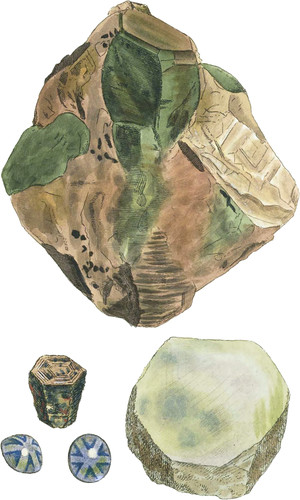 Enlarge
Enlarge
Exotic Mineralogy
We have figured the present Corundum in the matrix as an instructive and interesting specimen in Geology. At the same time it is a fresh proof of the identity of Corundum and Oriental Ruby, although at first sight so different in appearance from a gem. The principal crystal extends through the matrix, and is an irregular prism, whose upper end is tolerably perfect, and contains the commencement of a pyramid and the remains of the primitive faces, as in No. 10 of Tab. 43. On the left hand side is part of another crystal which is terminated, and seems to have been divided by, a plate of Mica, and the form of which is very irregular. The matrix consists of brownish rod Feldspar, Mica, Suboxide of Iron, and Fibrolite, This specimen is from China, it was lent me by the Count de Boumon.
The lower figure on the right hand is part of a large crystal from the Carnatic, for the figure of which I am indebted to the Trustees of the British Museum; it shows the horizontal fracture and common colour of that variety of Corundum.
The other figures exhibit the most remarkable varieties of Corundum; the uppermost is part of an hexaëdral pyramid from Ava; it appears to be formed of numerous coats, and so imperfectly aggregated, that its laminæ are in parts open enough to admit of the reflection of light between them, giving the crystal a peculiar lustre when broken horizontally, and also showing numerous concentric hexagons. These crystals when cut in an oval form, exhibit a luminous star Avith six points, the centre of which coincides with the apex of the nucleus.
The Oriental Rubies frequently exhibit similar appearances upon the terminal faces of their pyramids, and what properly cut also show the star, from whence they are named by Jewellers, Star-stones; I have tried to represent two views of a very fine one belonging to E. W. Rundell, Esq. to whom I am indebted for the loan of it. It shows not only the principal star commonly observed, but also another more faint produced by a second reflection.
Among the small rough Rubies brought from Ceylon, are often fragments of the star stones, rounded sufficiently by attrition to exhibit one or two points, and the colours of these are often of a delicate red or pink, shaded by violet.

